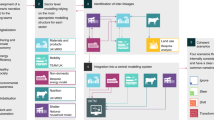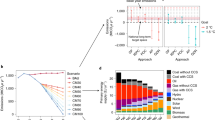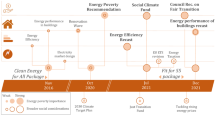Abstract
Progress towards climate protection has been modest over the past decades despite the ever-increasing urgency for concerted action against global warming. Partly as a response to this, but more directly as a means to promote sustainable development and poverty eradication, the United Nations has initiated a process to promote three global energy objectives: energy access, renewable energy and energy efficiency. Here we discuss the consistency of the proposed energy-related objectives with the overarching climate goal of limiting global temperature increase to below 2 °C. We find that achieving the three energy objectives could provide an important entry point to climate protection, and that sustainability and poverty eradication can go hand in hand with mitigating climate risks. Using energy indicators as the sole metrics for climate action may, however, ultimately fall short of the mark: eventually, only limits on cumulative greenhouse gas emissions will lead to stringent climate protection.
This is a preview of subscription content, access via your institution
Access options
Subscribe to this journal
Receive 12 print issues and online access
$209.00 per year
only $17.42 per issue
Buy this article
- Purchase on Springer Link
- Instant access to full article PDF
Prices may be subject to local taxes which are calculated during checkout




Similar content being viewed by others
References
Rogelj, J. et al. Copenhagen Accord pledges are paltry. Nature 464, 1126–1128 (2010).
Peters, G. P. et al. Rapid growth in CO2 emissions after the 2008–2009 global financial crisis. Nature Clim. Change 2, 2–4 (2012).
Friedlingstein, P. et al. Update on CO2 emissions. Nature Geosci. 3, 811–812 (2010).
Montzka, S. A., Dlugokencky, E. J. & Butler, J. H. Non-CO2 greenhouse gases and climate change. Nature 476, 43–50 (2011).
Meinshausen, M. et al. Greenhouse-gas emission targets for limiting global warming to 2 °C. Nature 458, 1158–1162 (2009).
Allen, M. R. et al. Warming caused by cumulative carbon emissions towards the trillionth tonne. Nature 458, 1163–1166 (2009).
Smith, S. M. et al. Equivalence of greenhouse-gas emissions for peak temperature limits. Nature Clim. Change 2, 535–538 (2012).
Zickfeld, K., Eby, M., Matthews, H. D. & Weaver, A. J. Setting cumulative emissions targets to reduce the risk of dangerous climate change. Proc. Natl Acad. Sci. USA 106, 16129–16134 (2009).
Matthews, H. D., Gillett, N. P., Stott, P. A. & Zickfeld, K. The proportionality of global warming to cumulative carbon emissions. Nature 459, 829–832 (2009).
Solomon, S. et al. Persistence of climate changes due to a range of greenhouse gases. Proc. Natl Acad. Sci. USA 107, 18354–18359 (2010).
Huber, M. & Knutti, R. Anthropogenic and natural warming inferred from changes in Earth's energy balance. Nature Geosci. 5, 31–36 (2012).
Matthews, H. D. & Caldeira, K. Stabilizing climate requires near-zero emissions. Geophys. Res. Lett. 35, http://dx.doi.org/10.1029/2007gl032388 (2008).
RCP Database (version 2.0), http://www.iiasa.ac.at/web-apps/tnt/RcpDb (2009).
Meinshausen, M. et al. The RCP greenhouse gas concentrations and their extensions from 1765 to 2300. Clim. Change 109, 213–241 (2011).
Boden, T. A., Marland, G. & Andres, R. J. Global, Regional, and National Fossil-Fuel CO 2 Emissionshttp://dx.doi.org/10.3334/CDIAC/00001_V2012 (2012).
United Nations in The Future We Want. Proc. Rio+20 UN Conference on Sustainable Development: A/CONF.216/L.1, 20–22 June 2012, 1–53 (United Nations, 2012).
United Nations Sustainable Energy for All 1–12 available via http://go.nature.com/F5eqSc (2011).
The Secretary-General's High-level Group on Sustainable Energy for All. Sustainable Energy for All: A Framework for Action 23 Available via http://go.nature.com/IDerp6 (2012).
UNEP and WHO The Energy Access Situation in Developing Countries: A Review Focussing on the Least Developed Countries and Sub-Saharan Africa 142 (UNEP/WHO, 2009).
Kaya, Y. Impact of carbon dioxide emission control on GNP growth: Interpretation of proposed scenarios. (Paper presented to the IPCC Energy and Industry Subgroup, Response Strategies Working Group, 1990).
Lawn, P. The need to move to a qualitatively-improving steady-state economy to resolve the climate change dilemma. Int. J. Green Econ. 4, 393–428 (2010).
IPCC Climate Change 2007: Mitigation (eds Metz, B., Davidson, O.R., Bosch, P.R., Dave, R. & Meyer, L.A.) 860 (Cambridge Univ. Press, 2007).
Fischedick, M. et al. in IPCC Special Report on Renewable Energy Sources and Climate Change Mitigation (eds Edenhofer, O. et al.) Ch. 10 (Cambridge Univ. Press, 2011).
Yumkella, K., Nakicenovic, N., Bazilian, M. & Jewell, J. The Sustainable Energy for All initiative and climate change mitigation. WMO Bull. 61, 15–17 (2012).
Riahi, K. et al. in Global Energy Assessment: Toward a Sustainable Future, 1203–1306 (Cambridge Univ. Press and IIASA, 2012).
McCollum, D. L., Krey, V. & Riahi, K. An integrated approach to energy sustainability. Nature Clim. Change 1, 428–429 (2011).
Kelly, J. A. An Overview of the RAINS Model. Report No. 1-84095-208–3, 35 (Environmental Protection Agency, 2006).
Clarke, L. et al. International climate policy architectures: Overview of the EMF 22 International Scenarios. Energy Econ. 31, S64–S81 (2009).
Van Vuuren, D. et al. RCP2.6: Exploring the possibility to keep global mean temperature increase below 2 °C. Clim. Change 109, 95–116 (2011).
Wise, M. A. et al. Implications of limiting CO2 concentrations for land use and energy. Science 324, 1183–1186 (2009).
Nakicenovic, N. & Swart, R. IPCC Special Report on Emissions Scenarios, 570 (Cambridge Univ. Press, 2000).
Armstrong, J. S. & Green, K. C. Forecasting Dictionary, http://www.forecastingprinciples.com/ (2012).
O'Neill, B. C., Riahi, K. & Keppo, I. Mitigation implications of midcentury targets that preserve long-term climate policy options. Proc. Natl Acad. Sci. USA 107, 1011–1016 (2009).
Riahi, K., Gruebler, A. & Nakicenovic, N. Scenarios of long-term socio-economic and environmental development under climate stabilization. Technol. Forecast. Soc. Change 74 (Greenhouse Gases: Integrated Assessment special issue), 887–935 (2007).
Rogelj, J., McCollum, D., Reisinger, A., Meinshausen, M. & Riahi, K. Probabilistic cost distributions for climate change mitigation. Nature 493, 79–83 (2013).
Rogelj, J., McCollum, D., O'Neill, B. & Riahi, K. 2020 emission levels required to limit warming to below 2 °C. Nature Clim. Change http://dx.doi.org/10.1038/nclimate1758 (2012).
Meinshausen, M., Raper, S. C. B. & Wigley, T. M. L. Emulating coupled atmosphere–ocean and carbon cycle models with a simpler model, MAGICC6. Part 1: Model description and calibration. Atmos. Chem. Phys. 11, 1417–1456 (2011).
Rogelj, J., Meinshausen, M. & Knutti, R. Global warming under old and new scenarios using IPCC climate sensitivity range estimates. Nature Clim. Change 2, 248–253 (2012).
IPCC Climate Change 2007: The Physical Science Basis (eds Solomon, S. et al.) 994 (Cambridge Univ. Press, 2007).
IEA World Energy Outlook 2010 (International Energy Agency, 2010).
Pachauri, S. et al. in Global Energy Assessment: Toward a Sustainable Future 58 (Cambridge Univ. Press and IIASA, 2012).
Ekholm, T., Krey, V., Pachauri, S. & Riahi, K. Determinants of household energy consumption in India. Energy Policy 38, 5696–5707 (2010).
Reddy, B. S. Overcoming the energy efficiency gap in India's household sector. Energy Policy 31, 1117–1127 (2003).
IPCC Special Report on Renewable Energy Sources and Climate Change Mitigation (eds Edenhofer, O. et al.) (Cambridge Univ. Press, 2011).
IPCC Special Report on Carbon Dioxide Capture and Storage (eds Metz, B. et al.) (IPCC, Cambridge, United Kingdom and New York, NY, USA, 2005).
Grubler, A. et al. in Global Energy Assessment: Toward a Sustainable Future, 99–150 (Cambridge Univ. Press, 2012).
McCollum, D. L. et al. Climate policies can help resolve energy security and air pollution challenges. Clim. Change http://dx.doi.org/10.1007/s10584-013-0710-y (in the press).
IEA IEA Data Services (Online Statistics) http://data.iea.org (2010).
Boden, T. A., Marland, G. & Andres, R. J. Global, Regional, and National Fossil-Fuel CO2 Emissions http://cdiac.ornl.gov/trends/emis/overview.html (2010).
Acknowledgements
We thank N. Nakicenovic, L. Gomez-Echeverri, J. Jewell and V. Krey for discussions about initial research questions, and P. Kolp for his technical support. J.R. was supported by the Swiss National Science Foundation (project 200021-135067) and the IIASA Peccei Award Grant.
Author information
Authors and Affiliations
Contributions
J.R. and K.R. designed the research; J.R. performed the research; all authors contributed to writing the paper. D.L.M. and K.R. are listed in alphabetical order.
Corresponding author
Ethics declarations
Competing interests
The authors declare no competing financial interests.
Rights and permissions
About this article
Cite this article
Rogelj, J., McCollum, D. & Riahi, K. The UN's 'Sustainable Energy for All' initiative is compatible with a warming limit of 2 °C. Nature Clim Change 3, 545–551 (2013). https://doi.org/10.1038/nclimate1806
Received:
Accepted:
Published:
Issue Date:
DOI: https://doi.org/10.1038/nclimate1806
This article is cited by
-
The cost of electrifying all households in 40 Sub-Saharan African countries by 2030
Nature Communications (2023)
-
The complex impacts of economic growth pressure on carbon emission intensity: an empirical evidence from city data in China
Environmental Science and Pollution Research (2023)
-
Cognition of agriculture waste and payments for a circular agriculture model in Central China
Scientific Reports (2020)
-
A quantitative analysis of 10 multilateral development banks’ investment in conventional and renewable power-generation technologies from 2006 to 2015
Nature Energy (2018)
-
Mapping interactions between the sustainable development goals: lessons learned and ways forward
Sustainability Science (2018)



